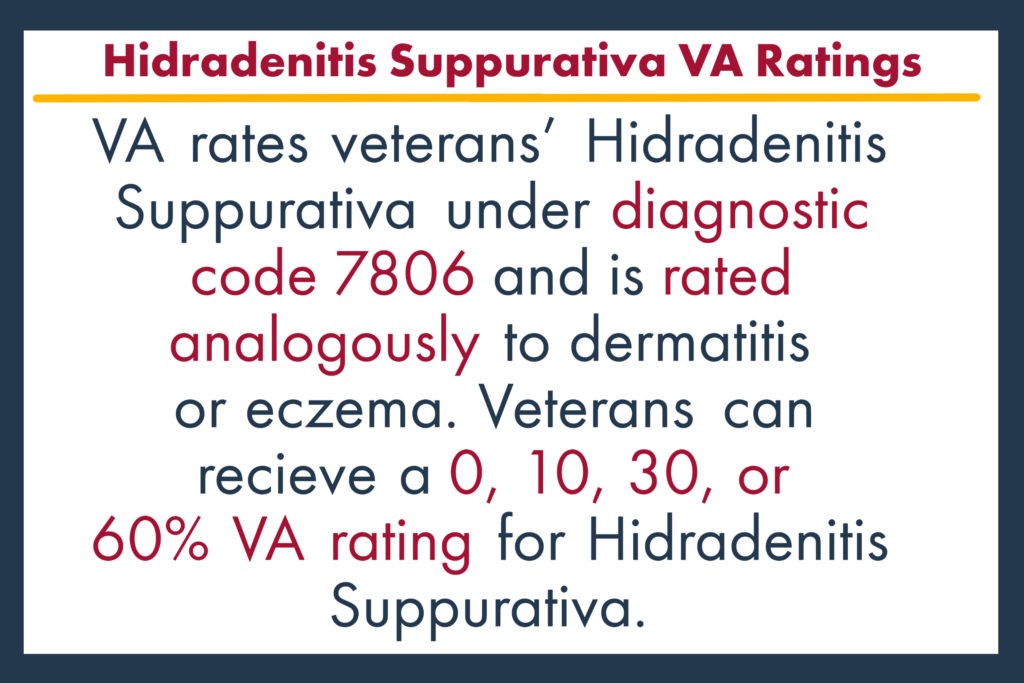VA Disability Ratings for Hidradenitis Suppurativa

What is Hidradenitis Suppurativa?
Hidradenitis Suppurativa is a rare disease that can cause painful lumps under the skin. These bumps are most commonly found in the groin or armpits. They can break open, much like a pimple might, and ooze a foul-smelling liquid.
Hidradenitis suppurativa is frequently misdiagnosed. Sometimes doctors can diagnose this condition as boils, infected hair follicles, or even as a sexually transmitted disease.
As a result, people with hidradenitis suppurativa can go years without receiving the correct treatment. Studies have indicated that some people live with this condition for twelve years or longer before receiving a proper diagnosis.
Importantly, hidradenitis suppurativa is not contagious, not a sexually transmitted disease, and not caused by unclean skin or uncleanliness.

Common Symptoms
Hidradenitis suppurativa is categorized by the lumps that form, break, ooze, and potentially reform in the armpit, groin, or similar areas. Certain conditions can occur in conjunction with hidradenitis suppurativa such as:
- Anxiety
- Depression
- Bacterial Infections
- Itching
- Pain
- Scars, which often restrict movement
- Skin cancer, specifically squamous cell carcinoma in men
Causes of Hidradenitis Suppurativa
The causes of hidradenitis suppurativa are still somewhat of a mystery. So far, scientists have determined that hidradenitis suppurativa is likely caused when hair follicles become clogged:
- Keratin, a protein found in skin, hair, and nails, clogs the hair follicle.
- Keratin and sweat build-up, since they can no longer flow out of the clogged hair follicle. Bacteria then begins to breed.
- More sweat, keratin, and bacteria collect in the hair follicle, causing it to burst. The burst hair follicle causes a deep pimple or painful and swollen lump filled with pus.
- Pus, keratin, sweat, and bacteria pour out of the ruptured hair follicle. These materials can spread to nearby hair follicles.
- More hair follicles then become clogged by the materials and more lumps begin to form. Deep tunnels begin to form in the skin as more hair follicles burst. Some people may develop skin infections.
- Lumps heal and re-appear, leading to scars. Hidradenitis suppurativa can spread to the stomach, face, under the breasts, and other areas with thick, coarse hair.
People who have a blood relative who has hidradenitis suppurativa are more likely to develop the condition, due to genetics. For example, a person with one parent who has hidradenitis suppurativa faces a 1 in 2 chance of inheriting the genes which cause hidradenitis suppurativa.
Exposure to a trigger can also cause the disease. One of the most common exposures is through cigarette smoking. Research has indicated that between 70 and 90 percent of people who have hidradenitis suppurativa also smoke cigarettes.
A person’s weight can also play a factor, as people who are overweight are at a higher risk of developing hidradenitis suppurativa. This could be because the more overweight a person is, the more inflammation they might have in their body.
Women are more likely to get hidradenitis suppurativa than men, most likely due to hormones. For some women, hidradenitis suppurativa can flare up before menstruation. It may be less severe during pregnancy or after menopause.
Younger people are more likely to have hidradenitis suppurativa, typically between puberty and age 40. Other factors which could make a person more likely to develop the condition include a person’s race and if they have psoriasis.
Treatment
Typically, a dermatologist will help treat the disease and manage symptoms. However, it is important to note that hidradenitis suppurativa is not currently a curable condition. Instead, treatment may help limit flare-ups, heal wounds, and ease pain.
Dermatologists will likely create a treatment plan to help achieve these goals. A customizable treatment plan may include:
- Skincare plans
- Medication
- Treatment for infections
- Wound care
- Corticosteroid injections
- Laser hair reduction
- Incision and drainage
VA Service Connection for Hidradenitis Suppurativa
In order to receive VA disability benefits, veterans will need to provide three things to VA:
- An in-service event, injury, or illness;
- A current diagnosis by a medical professional; and
- A medical nexus, or link, between your in-service event, injury, or illness and your current diagnosis.
Veterans can submit a claim for VA disability benefits on VA Form 21-526EZ. This can be submitted via mail to the Evidence Intake Center or electronically through VA’s website.

VA Disability Ratings and Benefits for Hidradenitis Suppurativa
VA does not have a specific diagnostic code for hidradenitis suppurativa, meaning that the condition is rated analogously to similar conditions based on the symptoms.
For example, one of the diagnostic codes which may be used to rate hidradenitis suppurativa is Diagnostic Code 7806, which is typically used for dermatitis or eczema.
The rating criteria for this code is as follows:
60%–This rating is for veterans with:
- More than 40 percent of the entire body or more than 40 percent of exposed areas affected, OR
- Constant or near-constant systemic therapy such as corticosteroids or other immunosuppressive drugs required during the past 12-month period
30%–This rating is for veterans with:
- 20 to 40 percent of the entire body or 20 to 40 percent of exposed areas affected, OR
- Systemic therapy such as corticosteroids or other immunosuppressive drugs required for a total duration of six weeks or more, but not constantly, during the past 12-month period
10%–This rating is for veterans with:
- At least 5 percent, but less than 20 percent, of the entire body, or at least 5 percent, but less than 20 percent, of exposed areas affected, OR
- Intermittent systemic therapy such as corticosteroids or other immunosuppressive drugs required for a total duration of less than six weeks during the past 12-month period
0%–This rating is for veterans with:
- Less than 5 percent of the entire body or less than 5 percent of exposed areas affected, and; no more than topical therapy required during the past 12-month period
Other ratings which made be issued are for the disfigurement of the head, face, or neck (Diagnostic Code 7800) or scars (Diagnostic Codes 7801-7805).
Compensation and Pension (C&P) Exams for Hidradenitis Suppurativa
In order to issue a rating for hidradenitis suppurativa, VA may first request a Compensation and Pension (C&P) exam to examine the veteran’s skin and determine how it is affected by the condition.
A C&P exam is a physical evaluation performed by a VA examiner or a VA contracted examiner. The examiner will usually physically examine the veteran, as well as ask questions about the veteran’s service or day-to-day symptoms of their condition.
The examiner should be knowledgeable about the information in a veteran’s c-file. A c-file contains any documentation that VA has regarding previously submitted claims, as well as the veteran’s medical and service records.
Veterans may also use a DBQ, or Disability Benefits Questionnaire, to help support their claim. This is a specific form created by VA with the aim of giving veterans a chance to address important aspects of their condition, such as symptoms, severity, and potential causes. With this form, veterans can speak to how their hidradenitis suppurativa is connected to their service.
The most important thing about C&P exams is attendance. If you fail to attend a C&P exam, VA may deny your claim. This is especially important in claims for hidradenitis suppurativa, as an examiner will generally need to determine how much of the body is affected by the condition in order to issue a rating. If you do not attend the exam, VA may not be able to grant service connection and issue a rating.
When VA schedules you for a C&P exam, it may call the phone number they have on file or send a letter to your address. It is critical that veterans ensure VA has the most up-to-date contact information so that they do not miss any C&P exam requests. If you did miss a C&P exam, you should contact VA as soon as possible to see if you can reschedule.

VA Individual Unemployability (TDIU) and Hidradenitis Suppurativa
Veterans with severe hidradenitis suppurativa may be prevented from working or maintaining employment because of their condition. Total disability based on individual unemployability (TDIU) is a monthly benefit that compensates veterans at the 100 percent rate, regardless of their actual combined rating.
There are generally two ways that a veteran’s hidradenitis suppurativa may qualify for TDIU:
- For schedular TDIU, veterans must meet the criteria listed under 38 CFR § 4.16a.The criteria stipulate that veterans must have one condition rated at 60 percent minimum OR two conditions that can be combined to reach 70 percent, where one condition is at a minimum of 40 percent. With hidradenitis suppurativa, a veteran may be eligible if they are awarded the 60 percent rating, even if it is technically rated as dermatitis or eczema, OR if their rating for hidradenitis suppurativa helps them reach a combined rating of 70 percent.
- Veterans who do not meet these qualifications may be eligible for extraschedular TDIU. For this form of TDIU, veterans must prove that their condition(s) uniquely hinders their ability to maintain substantially gainful employment. Extraschedular TDIU is rated under 38 CFR § 4.16b.
Get Help With Your Denied VA Disability Claim
Veterans with hidradenitis suppurativa can often benefit from accredited representation in the VA claims and appeals process. Several factors complicate benefits for this condition, such as the fact that it does not have its own diagnostic code and must be rated analogously to other conditions.
If you need accredited representation to help guide you through your appeal for VA disability benefits for hidradenitis suppurativa, Chisholm Chisholm & Kilpatrick may be able to help. Our experienced team has helped many veterans win the benefits they deserve. Call today for a free case evaluation to see if we may be able to assist at 800-544-9144.
About the Author
Share this Post


